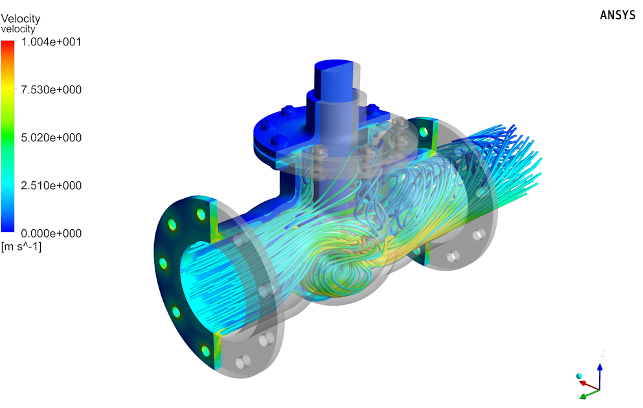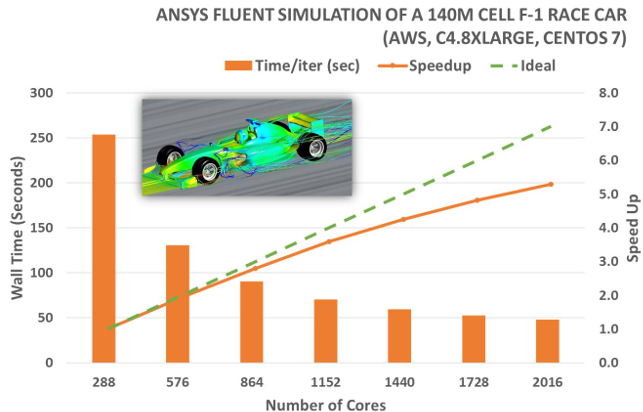Today’s designers and engineers are creating ever more complex and large-scale simulations in order to deliver robust and optimised designs.
However, they can often bump against the limits of their computer workstations and servers. High-performance computing (HPC) is a key strategic enabler of such simulations however, even the most powerful hardware will fail to deliver on its full potential unless mated with simulation software designed especially for HPC environments.


For today’s product designs, simulations are larger and more numerically complex than ever
For a number of years, Ansys has provided a variety of HPC-ready solutions.
These can be launched within a workgroup or across a distributed enterprise – whether users are utilising local workstations, department clusters or enterprise servers.
However, Ansys is now making HPC available on the cloud with its Ansys Enterprise Cloud solution – a turn-key, end-to-end simulation platform, which includes remote graphics, HPC job orchestration and remote session management, for global deployment.
With its web interface, users can monitor and make changes to their simulations virtually anywhere and at any time. Powered by the ANSYS Cloud Gateway, this single-tenant solution can be used as a direct extension of a company’s IT infrastructure and resources while leveraging the global platform of Amazon Web Service (AWS).
D3D: What type of firms are most interested in doing HPC on the Cloud? Small, large, multinationals?
Wim Slagter, Director for High Performance Computing (HPC) and Cloud Alliances at ANSYS: Cloud computing is increasingly being explored by our customers as a cost-effective alternative and addition to on-premise computing resources.
We see that SMEs are primarily interested because they can avoid/reduce in-house investment in IT staff or hardware for setting up and maintaining HPC.
Within larger enterprises we see a clear focus on a (private, hosted or public cloud) environment that minimises operational and capital costs, while enhancing end-user productivity. They are looking for a cloud solution that will also protect their simulation intellectual property (IP), while enabling collaboration among geographically distributed engineering teams.
D3D: What types of jobs are best suited — CFD, FEA, multiphysics, size, complexity, etc.?
WS: Cloud for simulation is fundamentally about getting access to computing power but not all simulation workloads will require the same cloud back end. If you’re after extreme HPC scaling, you may need to go to a national lab where 10,000’s of cores can be allocated to a single job.
If you’re after running on 1000’s of cores, cloud computing with an InfiniBand network fabric (as offered by our cloudhosting partners) would be required.
If you’re running on 10’s –100’s of cores, or trying to get throughput for 100 or 1000 simultaneous jobs – to explore a design space – you may run on a public cloud like AWS (for example through our Enterprise Cloud solution).

Pressure contours and path lines on a Bugatti Veyron. Using Ansys HPC solutions will result in a significant reduction in modelling process times
D3D: Engineering datasets and simulation results data can be huge. What mechanisms do you have in place to minimise / accelerate data transfer?
WS: Because simulation results data can indeed be huge, one of our cloud computing best practices is to minimise the transfer of data back and forth between the cloud back end and the end user.
This can only be accomplished when end users are able to perform full end-to-end simulation on the cloud, meaning not just batch solves but also interactive Graphical User Interface (GUI) processes and graphical post-processing. Most simulation workloads involve 3D graphics, so you need a remote graphics software tool with server-side acceleration and good performance over the network — and reasonable network latency. And you want full remote desktop access to that server (not just the application in a window) so that you can edit and manage files, compile add-in routines, etc.
All this implies that a graphics server on the cloud needs sufficient memory to load and display large simulation models. One common issue is that not all cloud back ends support this.
Last but not least, a solution architecture is required that uses a high-memory server instance to run the application and that handles graphics via external rendering on a lowermemory graphics server.
D3D: Are you finding firms are interested in using cloud on its own, or a combination of workstations, local servers/clusters and cloud?
WS: For ANSYS customers, cloud computing (whether it is private, hosted or public cloud) is inherently tied to the growing need for HPC resources to support bigger and more demanding engineering simulation workloads, either for steady-state requirements or occasional peak capacity.
Some customers who need greater access to HPC lack the expertise and/or time to specify and manage substantial HPC resources. Cloud may also be an enabler for those with significant internal HPC resources, but urgent unexpected or unplanned projects, arising in response to product performance issues with deployed products (equipment shutdown, product failure, warranty issues).
Others may have occasional need for high simulation throughput, to support robust design practices and/or extreme fidelity models that are part of a short-term project.

A graph depicting HPC scaling
D3D: How do firms pay for different levels of compute power?
WS: If you refer to hardware (cycle) costs, then this can best be answered by cloud service providers.
D3D: What advice do you offer firms that are worried about the security of their confidential data?
WS: Let me first say that because simulation models contain the “crown jewels” (i.e. product data) of the firm, the customer needs to be convinced that this data is secure and IP is protected.
Having said that, cloud computing still suffers from a perception problem when it comes to security. In my opinion, the cloud in and of itself is no more or less secure than other models. It depends on the measures organisations and providers take to secure the data. It is clear that if policies and procedures aren’t robust, then data will be vulnerable wherever it is hosted on-premise or in the cloud. I would also contend that many cloud providers likely have better security than most organisations because of the economies of scale of their business.
Moreover, it is common practice that cloud service providers hire the world’s best talent as they focus on security as a core part of their business. In addition to other security methods, AWS, for example, provides a complete set of network security, encryption, identity and compliance tools, as well as over 50 global assurance programs to ensure sensitive workloads can operate on AWS in compliance with relevant laws and regulations.
For more information on the Ansys Enterprise Cloud solution and to watch a webinar entitled ‘Secure engineering simulation workflows in the cloud’ click here






